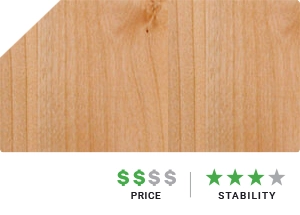
Understanding Flush Core Surface Options
When it comes to choosing the perfect flush doors, a lot of time and effort will go into choosing the pattern, grain direction, wood type and stain color. Let’s explore an aspect of the door that is not often discussed but plays a pivotal role in both stability and aesthetics: Wood surface skin thickness.
The Thin or the Thick: Stability & Aesthetics
In the context of what we are speaking to here, stability is resistance to the natural movement of wood in response to changes in environment, primarily humidity. Wood, being a hygroscopic material, expands and contracts with fluctuations in moisture levels. The thickness of the wood directly influences the extent of this movement.
The general rule of thumb:
thinner the wood = more stable (i.e. less movement)
Movement by Wood Type
Different wood species also react differently to changes in humidity. In simple terms: certain wood types are more stable than others. White Oak for example will have more movement to environmental changes than Alder will.
You could deep dive into the scientific study of wood movement and check out further information on Equilibrium Moisture Content (EMC) tables and the Dimensional Change Coefficients by respective wood types. Or, feel free to use the quick look guides found throughout the Treely Doors™ website showing stability rankings for each wood type offered.

Different Climates = Different Challenges
Throughout the United States there are vast differences in climate conditions, which is key to remember when choosing the best wood for your interior doors. Depending on the location, certain wood species and thicknesses are going to be better choices both for the structural stability of the door and for their aesthetic qualities.
If you have any questions about wood stability or what options are best for your particular project, please don’t hesitate to reach out. Treely Doors™ sells throughout the United States and we are here to help guide you to the best production selection for your project’s needs.